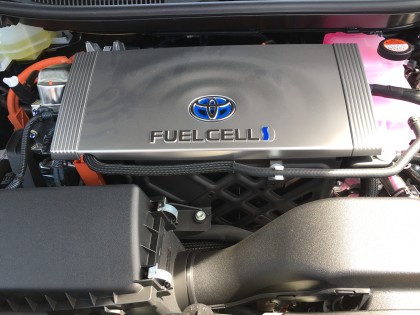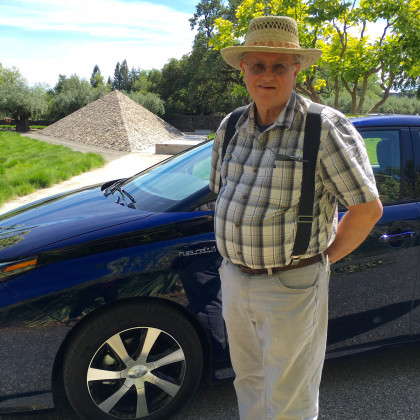Heading down the Hydrogen Highway

The year was 2005, and it was former Governor Arnold Schwartzenegger, who, with his hydrogen-fueled Hummer, put his name and reputation behind developing a “hydrogen highway.” In the ensuing years, however, enthusiasm for hydrogen-powered transportation fell out of favor; unavailable fueling stations, slowed research and development and pressure from the fossil fuel industry in fear of “stranded assets” we’re among the reasons. Public fears that hydrogen is too explosive, improved gasoline fuel mileage and hybrid electric/gasoline vehicles also made hydrogen fuel seem less attractive.
Recently, however, automakers Honda and Toyota are making an increased effort to promote hydrogen-fueled vehicles, employing an energy source called fuel cell technology. Toyota’s fuel-cell vehicle is called a “Mirai”, and we were recently invited to see it and enjoy a ride by Michael Bartlett, “Shop Manager” at Stone Edge Farm here in Sonoma Valley, which has recently acquired two of them.
Michael has become an expert in emerging energy technology, and shared his expertise with the SUN. “One kilogram of hydrogen is equivalent to one BTU of gasoline,” Michael explained, “which means that in a typical MPG comparison to gasoline, hydrogen provides 67 miles-per-gallon as compared with 21 for a gasoline-powered internal combustion vehicle, on average.” Hydrogen fuel cell vehicles have been given a special category for indicating mileage by the EPA, namely “MPGe”. “Hydrogen, of course, is the most common element in the universe,” Michael noted, “and a hydrogen fuel cell provides zero emissions energy.”
In order to produce hydrogen for fuel, it must be “refined”. This can be done through two methods; the first is Steam Reformation, which uses heat energy and refining equipment to extract hydrogen from natural gas or methane from land fills. This method requires the removal of hydrocarbons and various impurities.
The second method is through electrolysis of water. Water, of course, is the molecular combination of hydrogen and oxygen atoms. Electrolysis uses electricity to break the bonds of water molecules, at which point the two elements can be separated, purified and stored. Any water source can be used in electrolysis, even recycled or “gray” water.
Currently, few locations for filling fuel cell vehicles exist in the Bay Area; two are in construction presently in Marin County, and one is planned in Rohnert Park; one facility already is in operation in South San Francisco. In addition, improvements in technology are making smaller-scale, independent hydrogen-producing facilities possible in the future. However, given the mileage of fuel cell vehicles, refueling need not happen too often. Re-fueling takes approximately 3-8 minutes, depending upon the fueling pressure.

“The range of the fully-fueled Mirai is 312 miles,” explained Michael. “Its tank capacity is five kilograms of pressurized hydrogen gas; hydrogen is always expressed in kilograms.” The fuel cell produces electricity through a chemical reaction combining hydrogen and oxygen; when combined, the fuel cell produces heat, electricity and, of course, some water. The electricity is then used by the car’s motors to activate the drive train.
The high-pressure hydrogen gas is contained within specially designed tanks made of high-strength composite materials designed to be fire and explosion-proof. “You could burn down your garage and the tanks would still be fine,” Michael stressed. “People have been afraid of hydrogen, but it’s the lightest of gasses and rises up into the air very rapidly. Hydrogen gas dissipates quickly.”
The Marai uses the same drive train as the Toyota Prius; this system also employs regenerative features that capture electricity from breaking and coasting. The driving experience is also quite similar. “People are getting accustomed to the feel of electric vehicles. The Marai has more power than a Prius but driving a Marai is a comparable experience,” Michael explained.
One might expect the cost of a fuel cell vehicle to be high, and the Marai is priced at $57,000. However, a state rebate of $5,000 is available, and in 2016 a federal tax credit of $8,000 can be used. What’s more, Toyota offers a $15,000 fueling credit and an 8-year, 100,000-mile warranty on the fuel cell and its associated components.
Not everyone is a fan of fuel cells. Elon Musk of Tesla is a critic of fuel cell technology, which he calls “fool cell” technology. He prefers his lithium-ion battery technology. Toyota has been explicit in declaring that it plans to phase-out fossil fuel vehicles, and strongly supports hydrogen fuel cell vehicles. In either case, gasoline is “dirty”; when burned, one gallon of gasoline produces 20 lbs. of CO2 emissions. With Californians collectively driving three-billion miles each year, that’s a lot of CO2.
Honda Motors also offers a hydrogen fuel cell car, the “Clarity”, and will be making it available in California in 2017. It reportedly has a range of 425 miles, and its fuel cell is supposedly more efficient than Toyota’s. Ironically, fuel cell technology is not new, the first 5-kilowatt fuel cell having been introduced in 1939. But given today’s concerns about global warming, fuel cell transportation’s time may have finally arrived, and with it a revolution in energy production.
Of course, any revolution comes with costs; a massive transfer of wealth will accompany fuel cell technology as older energy sources are phased out. One example of a transition of this sort is the recent bankruptcy of America’s largest coal company, Peabody Coal. An energy revolution will include not just new technologies but new entrepreneurs, CO2 removal systems, improved electrolysis systems and highly increased efficiencies. In anticipation, organizations like the California Fuel Cell Partnership are planning hydrogen power infrastructure development and certification programs. Certification is already part of the fuel cell system; Toyota will void its warranty unless all hydrogen fuel used in its fuel cell vehicles comes from a supplier certified by Toyota.
One of the most interesting areas in development is what’s called a “power take-off unit.” This unit will allow a vehicle’s fuel cell to connect to a home to generate power, particularly during emergencies. Fuel cells do not store energy at present, only generate it. However, new storage battery technology will bridge the gap and form the basis, in the words of Michael, of a “multi-modal, reversible technology.” Thus hydrogen is viewed by many not simply as fuel, but as an “energy carrier.”
Mercedes, Michael recounted, is also developing fuel cell vehicles, and performed an interesting experiment – a three-day desert survival drive. Since fuel cells also produce pure water as a by-product of energy production, the team driving the vehicle was limited to drinking only water produced by their vehicle’s operation. “They survived just fine,” according to Michael.



